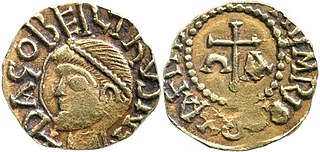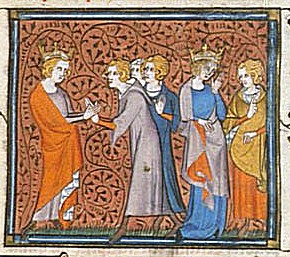
Year 639 (DCXXXIX) was a common year starting on Friday of the Julian calendar. The denomination 639 for this year has been used since the early medieval period, when the Anno Domini calendar era became the prevalent method in Europe for naming years.

Year 641 (DCXLI) was a common year starting on Monday of the Julian calendar. The denomination 641 for this year has been used since the early medieval period, when the Anno Domini calendar era became the prevalent method in Europe for naming years.

Pepin Iof Landen, also called the Elder or the Old, was the Mayor of the palace of Austrasia under the Merovingian King Dagobert I from 623 to 629. He was also the Mayor for Sigebert III from 639 until his death.

Austrasia was a territory which formed the north-eastern section of the Kingdom of the Franks from the 6th to 8th centuries, ruled by the Frankish Merovingian and Carolingian dynasties during the Early Middle Ages. It was centred on the Meuse, Middle Rhine, and the Moselle rivers, and was the original territory of the Franks, including both the so-called Salian Franks and Ripuarian Franks, which Clovis I, King of the Franks (481–511) conquered after first taking control of the bordering part of Roman Gaul, which is sometimes described in this period as Neustria.

Dagobert I was King of the Franks. He ruled Austrasia (623–634) and Neustria and Burgundy (629–639). He has been described as the last king of the Merovingian dynasty to wield real royal power. Dagobert was the first Frankish king to be buried in the royal tombs at the Basilica of Saint-Denis.

Chlothar II, sometime called "the Young", was king of the Franks, ruling Neustria (584–629), Burgundy (613–629) and Austrasia (613–623).

Neustria was the western part of the Kingdom of the Franks during the early middle ages, in contrast to the eastern Frankish kingdom, Austrasia. It initially included land between the Loire and the Silva Carbonaria, in the north of present-day France, with Paris, Orléans, Tours, Soissons as its main cities. The population was therefore originally largely Romanised.

The Carolingian dynasty was a Frankish noble family named after Charles Martel and his grandson Charlemagne, descendants of the Arnulfing and Pippinid clans of the 7th century AD. The dynasty consolidated its power in the 8th century, eventually making the offices of mayor of the palace and dux et princeps Francorum hereditary, and becoming the de facto rulers of the Franks as the real powers behind the Merovingian throne. In 751 the Merovingian dynasty which had ruled the Franks was overthrown with the consent of the Papacy and the aristocracy, and Pepin the Short, son of Martel, was crowned King of the Franks. The Carolingian dynasty reached its peak in 800 with the crowning of Charlemagne as the first Emperor of the Romans in the West in over three centuries. His death in 814 began an extended period of fragmentation of the Carolingian Empire and decline that would eventually lead to the evolution of the Kingdom of France and the Holy Roman Empire.

Childeric II was a King of the Franks. He ruled Austrasia from 662 and Neustria and Burgundy from 673 until his death, making him sole king for the final two years of his life.
Under the Merovingian dynasty, the mayor of the palace was the manager of the household of the Frankish king.

Clovis II was King of the Franks in Neustria and Burgundy, having succeeded his father Dagobert I in 639. His brother Sigebert III had been King of Austrasia since 634. He was initially under the regency of his mother Nanthild until her death in her early thirties in 642. Nanthild's death allowed Clovis to fall under the influence of the secular magnates, who reduced the royal power in their own favour; first Aega and then Erchinoald. The Burgundian mayor of the palace Flaochad used him to lure his rival, Willebad, to a battle in Autun, in which Willebad was killed.

The Kingdom of the Franks, also known as the Frankish Kingdom, the Frankish Empire or Francia, was the largest post-Roman barbarian kingdom in Western Europe. It was ruled by the Frankish Merovingian and Carolingian dynasties during the Early Middle Ages. Francia was among the last surviving Germanic kingdoms from the Migration Period era.

Theuderic III was King of the Franks. He ruled Neustria and Burgundy on two occasions, as well as Austrasia from 679 to his death in 691.

Sigebert III was the Merovingian king of Austrasia from 633 to his death around 656. He was described as the first Merovingian roi fainéant —do-nothing king—, in effect the mayor of the palace ruling the kingdom throughout his reign. However he lived a pious Christian life and was later sanctified, being remembered as Saint Sigebert of Austrasia in the Roman Catholic Church and Eastern Orthodox Church.

Dagobert III was Merovingian king of the Franks (711–715).
Erchinoald succeeded Aega as the mayor of the palace of Neustria in 641 and succeeded Flaochad in Burgundy in 642 and remained such until his death in 658.
Wulfoald was the mayor of the palace of Austrasia from 656 or 661 to his death, as well as mayor of the palace of Neustria and Burgundy from 673 to 675.

Nanthild, also known as Nantéchilde, Nanthechilde, Nanthildis, Nanthilde, or Nantechildis, was a Frankish queen consort and regent, the third of many consorts of Dagobert I, king of the Franks (629–639). She was regent during the minority of her son from 639 until 642.
Gundoland or Gundeland was the mayor of the palace of Neustria from 613 to his death. According to the Liber Historiae Francorum, he was nobilis, egregius, and industrius: noble, outstanding, and diligent.














